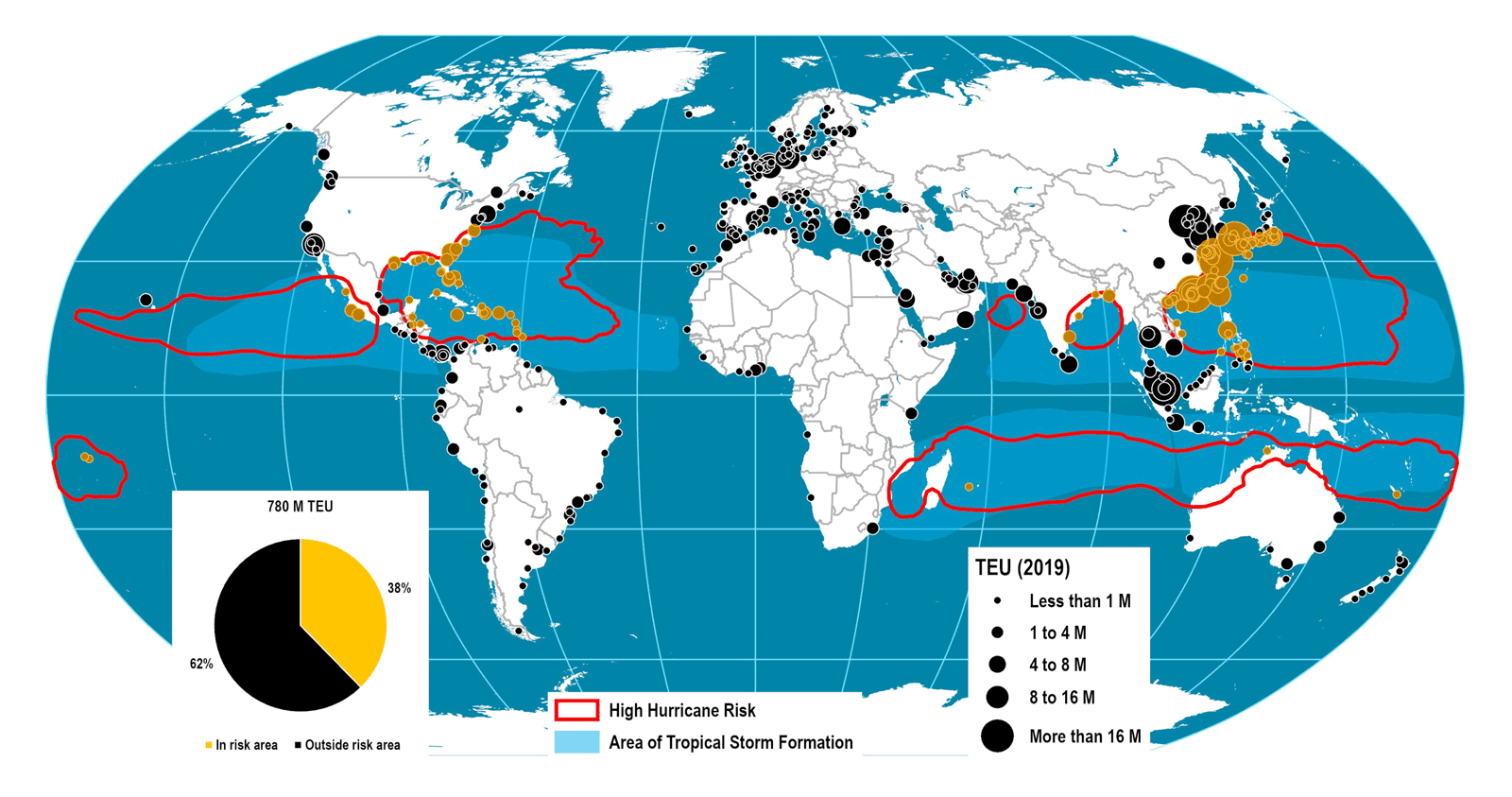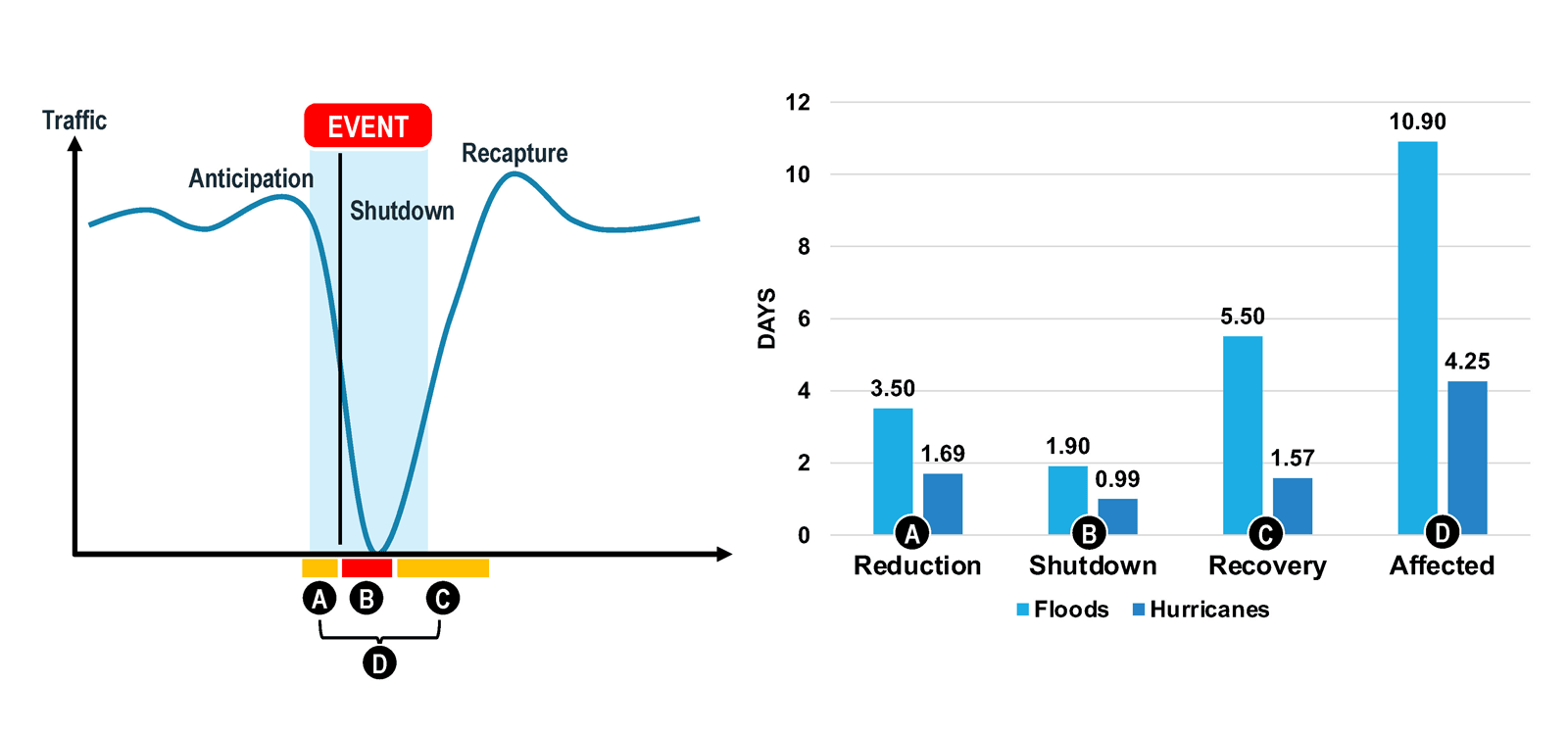The most common extreme weather events impacting ports are storms, hurricanes, heat waves and floods. Storms, including snowstorms and sandstorms, can be intense but of short duration (less than a day), and only affect a defined geographic area. Floods are a common type of weather hazard and can cause significant damage to infrastructure. Floods often occur following heavy rain, snowstorms, coastal storms, storm surges, and the overflow of dams and other water systems, particularly in delta areas.
Hurricanes represent a significant potential disruption to maritime shipping and port operations, and their impacts on ports are subject to a distinct geographical concentration of risks. Tropical storms emerge in intertropical convergence zones which are located just north of the equator for the Atlantic Ocean, and on both sides of the equator for the Pacific Ocean. A tropical storm may develop into a hurricane (or typhoon in Asia) with sustained winds above 100 km/hr, and can move beyond the formation areas and make landfall. High winds with the associated precipitations and tidal effects can substantially disrupt and damage coastal activities, including ports and their terminals. Another important characteristic of hurricanes is their seasonality, with peak activity usually occurring between June and October. The cycle is more acute in East Asia, which experiences a greater number of typhoons, which can occur year-round (figure 27).
About 38 per cent of global container port activity occurs in areas subject to high hurricane risk. With their high container port activity levels, the American Eastern Seaboard, coastal China, Japan and the Republic of Korea, are the areas facing higher levels of potentially disrupted areas. In addition to disrupting and halting port activity, hurricanes can damage port equipment and superstructure. Yard activity can be disrupted by toppled containers and flooder areas, damaging cargo and equipment. Connections with the hinterland can also be damaged, such as flooded road and rail connectors. On some acute occasions, port infrastructure, e.g. piers, can be damaged.
Figure 27: Risk of hurricanes for global container ports, 2019

Evidence from a sample of hurricanes and floods in two areas prone to hurricanes with a high density of port facilities – North and Central America and East Asia – depicts a typical impact sequence on port activity (figure 28).
Figure 28: Typical impact of hurricanes and flood events on port activity

Source: J. Verschuur et al (2020).
The path and intensity of hurricanes and the risk of floods can be predicted several days in advance, enabling ports to anticipate the event by rushing the handling of expected ships. As the weather event begins to be felt, a port may experience a reduction of activity as ships begin to divert to an unaffected port nearby or skip the port call altogether. Evidence shows that activity reduction spans over an average of 1.7 days for hurricanes and 3.5 days for floods. If the event is significant enough, the port will be forced to shut down, usually one day for hurricanes and close to two days for floods.
A container port usually takes one to two days to resume full operations (recovery) after a Category 1 hurricane. If a container port is a transshipment hub, the disruptions caused by a hurricane can be extensive for the schedule integrity of maritime shipping networks, and could convince shipping lines to use alternative hubs. Once able to re-open, and recovery begins to take place, port activity will resume its normal activities. There is likely to be a post-recovery surge where the port is trying to recapture the traffic that has been lost during the event (Figure 28).
Evidence shows that floods have the most substantial impacts on port operations, with the average number of affected days close to 11, compared with 4.25 days for hurricanes. Longer disruptions are associated with damage to hinterland infrastructure, preventing the port from being connected with its customers (See Case Study 14: Port of Houston, United States).
